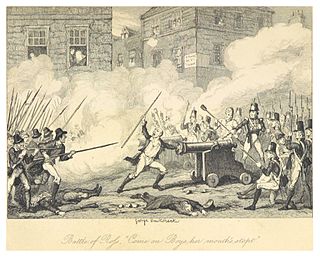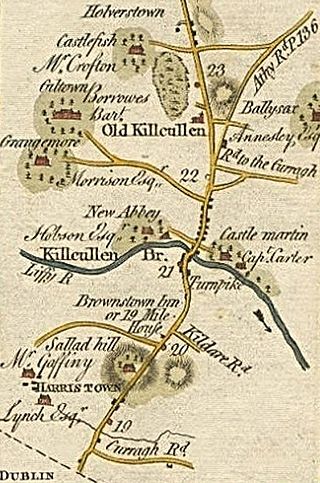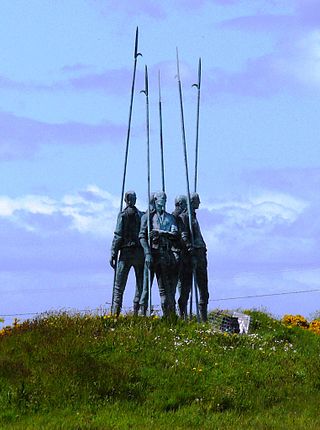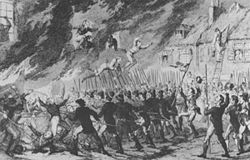
The Irish Rebellion of 1798 was a major uprising against British rule in Ireland. The main organising force was the Society of United Irishmen, a republican revolutionary group influenced by the ideas of the American and French revolutions: originally formed by Presbyterian radicals angry at being shut out of power by the Anglican establishment, they were joined by many from the majority Catholic population.

The Battle of New Ross was a military engagement which took place in New Ross, County Wexford during the Irish Rebellion of 1798. It was fought between the Society of United Irishmen rebels and government forces garrisoning the town. The attack on the town of New Ross on the River Barrow, was an attempt by the recently victorious rebels to break out of county Wexford across the river Barrow and to spread the rebellion into county Kilkenny and the outlying province of Munster.
The Battle of Ballymore-Eustace was one of the events in the United Irish rebellion of 1798. It took place on 24 May 1798 after the stationing of the 9th Dragoons, and members of the Tyrone, Antrim and Armagh Militias at Ballymore in County Kildare near the Kildare-Wicklow border on 10 May. The town had been recently garrisoned by almost 200 soldiers and militia who had been sent to repress sedition in the area. The troops had been dispersed in billets among the populace as per counter-insurgency practice of "free-quarters" where responsibility for the provisioning and sheltering of militia was foisted onto the populace. During this time a quantity of arms were surrendered and letters of protection issued.

The Battle of Kilcullen took place on 24 May 1798 near the two settlements of that name in County Kildare, and was one of the first engagements in the Irish Rebellion of 1798 consisting of two separate clashes between a force of United Irish rebels and British military.

The Battle of Vinegar Hill was a military engagement during the Irish Rebellion of 1798 on 21 June 1798 between a force of approximately 13,000 government troops under the command of Gerard Lake and 16,000 United Irishmen rebels led by Anthony Perry. The battle, a major rebel defeat, took place on 21 June 1798 on a large rebel camp on Vinegar Hill and in the streets of Enniscorthy, County Wexford where the Rebels took 11 minutes to get down from the hill led by Peggy the Black, and marked the last major attempt by the rebels to resist government forces in a pitched battle.

The Battle of Oulart Hill took place on 27 May 1798 when a rebel gathering of between 4,000 and 5,000 annihilated a detachment of 110 militia sent from Wexford town to stamp out the spreading rebellion in County Wexford.
The Carnew executions refer to the summary execution of 28 prisoners being held as suspected United Irishmen by yeomanry troops from the Carnew garrison stationed in the barracks of Carnew Castle, County Wicklow, Ireland on 25 May 1798.
The Battle of Ballyellis on 30 June 1798 was a clash during the Irish Rebellion of 1798, between a surviving column of the dispersed Wexford rebel army and pursuing British forces which resulted in a victory for the rebels.

The second Battle of Arklow took place during the Irish Rebellion of 1798 on 9 June when a force of United Irishmen from Wexford, estimated at 10,000 strong, launched an assault into County Wicklow, on the British-held town of Arklow, in an attempt to spread the rebellion into Wicklow and to threaten the capital of Dublin.
The battle of Ovidstown was a military engagement between British Crown forces and United Irishmen rebels during the Irish Rebellion of 1798 near the town of Kilcock, County Kildare. Despite the initial failures experienced by the United Irishmen in County Kildare during the first months of the rebellion, the consolidation of government forces in the town of Naas and the priority given by the Dublin Castle administration to suppress the Wexford Rebellion in County Wexford meant that much of the county remained in rebel hands since the outbreak of the rebellion. Towns such as Prosperous and Clane were in rebel hands, while towns such as Maynooth, Kilcock and Kildare had been attacked and briefly occupied by the rebels. By 19 June, however, neighbouring County Meath had been judged sufficiently pacified to allow for government forces to be dispatched from that county into Kildare to recapture rebel-held territory.
The Dunlavin Green executions was summary execution of 36 suspected United Irishmen rebels in County Wicklow, Ireland by the Irish Yeomanry shortly after the outbreak of the rebellion of 1798. There are several accounts of the events, recorded at differing times and differing in detail.

John Murphy was an Irish Roman Catholic priest of the Roman Catholic Diocese of Ferns, who is mainly remembered for his central role in the Irish Rebellion of 1798 in County Wexford, which is sometimes known as the Wexford Rebellion. He led the rebels to one of their initial victories over a government militia at Oulart Hill, and in the following weeks became one of the rebellion's main leaders.
Events from the year 1798 in Ireland.
The Battle of the Harrow took place on 26 May 1798 and was the first clash of the Irish Rebellion of 1798 in County Wexford. It was fought between government forces and United Irishmen insurgents under the leadership of a local priest, John Murphy who had mobilized following reports of atrocities by the yeomanry during the rebellion led by the United Irishmen revolutionary organisation.

General Sir William Lumley, was a British Army officer and courtier during the late eighteenth and early nineteenth centuries. The son of the Earl of Scarborough, Lumley enjoyed a rapid rise through the ranks aided by a reputation for bravery and professionalism established on campaign in Ireland, Egypt, South Africa, South America, Italy, Portugal and Spain. Following his retirement from the army due to ill health in 1811, Lumley served as Governor of Bermuda and later gained a position as a courtier to the Royal Household. Lumley is especially noted for his actions at the Battle of Antrim where he saved the lives of several magistrates and was seriously wounded fighting when leading a cavalry charge against the United Irishmen rebels in the Irish Rebellion of 1798.

The Wexford Rebellion refers to the outbreak in County Wexford, Ireland in May 1798 of the Society of United Irishmen's rebellion against the British rule. It was the most successful and most destructive of all the uprisings that occurred throughout Ireland during the 1798 Rising, lasting from 27 May 1798 until about 21 June 1798. The Wexford Rebellion saw much success despite County Wexford not being thought of as an immediate threat by the government, because of the spontaneous risings that occurred both before and after the significant rebel victories in Oulart, Enniscorthy, and Wexford town.

The battle of Ballynahinch was a military engagement of the Irish Rebellion of 1798 between a force of roughly 4,000 United Irishmen rebels led by Henry Munro and approximately 2,000 government troops under the command of George Nugent. After rebel forces had occupied Newtownards on 9 June, they gathered the next day in the surrounding countryside and elected Munro as their leader, who occupied Ballyhinch on 11 June. Nugent led a column of government troops in 12 June which recaptured the town and bombarded rebel positions. On the next day, the rebels attacked Ballyhinch, but were driven back and defeated.

The Battle of Saintfield was a short but bloody clash in County Down, in Northern Ireland. The battle was the first major conflict of the Irish Rebellion of 1798 in Down. The battle took place on Saturday, 9 June 1798.

The Battle of the Big Cross was a military engagement of the Irish Rebellion of 1798 between a force of United Irishmen rebels and a column of government troops. It was fought on 19 June 1798 on a spot on the Shannonvale-Ballinascarty road known locally as the "Big Cross", approximately four miles east of Clonakilty in West Cork. It was the only battle fought in the rebellion in County Cork.
John Esmonde was a physician from Sallins, County Kildare, and member of the United Irishmen, who was hanged in 1798 for having led the insurgents in the Battle of Prosperous, in Co. Kildare, during the risings of that year.














